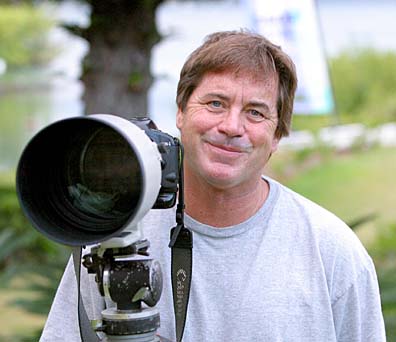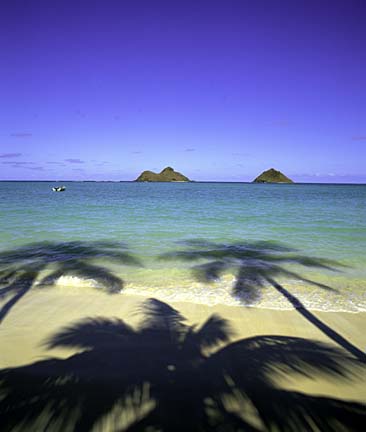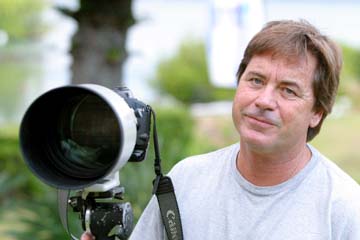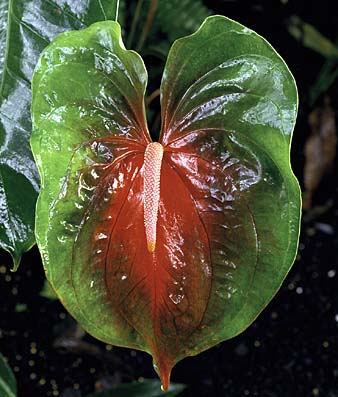

|
First Sunday Mark Coleman |
COURTESY JOHN PEEBLES
Douglas Peebles came to Hawaii in 1974, a surfer from Florida following his dream. He had intended to leave after six months and join some friends in the film business in Hollywood, but Hawaii captured his heart and he's been here ever since. Lucky for us.
The Jacksonville native, a graduate of Florida State University in Tallahassee, has seen and photographed more of Hawaii's vistas and landscapes than probably anyone alive, and presented his work for all to see in more than two dozen books during the past 20 years.
Many of the books have focused on particular islands, such as his recent "Oahu" (Mutual Publishing), and often feature large, panoramic photographs taken from the sky. As Hawaii's natural beauty changes over the years, the images in his books will become among the best windows into Hawaii's past.
For now, Peebles is in the forefront of landscape photography in Hawaii, and has focused his camera lenses on other destinations throughout the Pacific and the world as well. He keeps a file of his photographs and makes them available to entrepreneurs for calendars, postcards, album covers, books and other uses.
COURTESY DOUGLAS PEEBLES
Hawaii landscape photographer Doug Peebles features this photograph of the Mokulua Islands off Kailua, Oahu, from Lanikai Beach, in his book
He is widely published in magazines, occasionally sells photos to news services, and has done extensive work for advertising agencies. Among the collaborators on his many book projects have been writers such as Ronn Ronck, Chris Cook, Jan TenBruggencate and the late Glen Grant, and designers such as Momi Cazimero, Michael Horton and Leo Gonzales.
Peebles lives on Kaneohe Bay with his wife of 22 years, the former Margaret Porter. When I arrived to meet with him, the younger of his two sons, 17-year-old Kevin, was scanning many of his father's photographs into the computer so they could be digitally archived. His older son, John, 20, took the photo of his father that appears at top.
COURTESY JOHN PEEBLES
"Actually, gray skies -- soft light -- is a good thing for shooting plants and flowers. You see a lot more detail." --Douglas Peebles, photographer
Coffee-table books
Mark Coleman: I think a lot of people know your name but they don't really know from where, yet you probably have more coffee-table books in this state than anybody, yeah?Douglas Peebles: Yeah. I think the first one came out in about 1982 ("Majesty: The Exceptional Trees of Oahu," published by the Outdoor Circle).
MC: Can people still buy that book?
DP: It's out there. And then we did one 10 years later, "Majesty II," which featured more of the trees on the list (of "exceptional" trees) and ones that had been added since. A third book that was done through the Circle (in 1987) was "Pua Nani: Hawai'i is a Garden."
MC: Your latest book ("This is Kauai") showed up at work recently. I looked at it and thought, "This looks like Doug Peebles' work," even though your name wasn't anywhere on the cover. So I looked for your name on the inside and, sure enough, it was.
DP: What's funny about that is, I haven't seen the book yet. I knew it was coming, but the publisher didn't tell me it came in. (Laughs)
Personal style
MC: Your photography has a real distinctive look. It's real crisp and tends to be fairly panoramic. Is there something conscious going on there?DP: Yeah, I use a bold style in terms of the composition, and the colors are generally pretty strong. I'm looking for those times of day when I can either make use of bright sun or softer light. So I'm either trying to shoot early in the morning or late in the day with bright sun, or I'm trying to shoot in a flat-light situation.
MC: I wrote a news story about your first book back in 1982 ("Majesty"), and I remember it was mostly gray skies when you were shooting and all the pictures therefore had an odd illumination.
DP: Yeah, there were some. But actually, gray skies -- soft light -- is a good thing for shooting plants and flowers. You see a lot more detail.
MC: It seems that most of your photography that's out there for the public is landscape photography.
DP: Yeah, landscapes, scenic nature. I think that's what I'm most comfortable at. I love doing the books on trees, flowers and plants as well.
MC: It's mostly Hawaii, too.
DP: Oh yeah, although now I shoot a lot of work in the South Pacific, and I've been to Alaska a number of times as well.
MC: You told me earlier you've been to 45 countries. Where haven't you been?
DP: I'm going to New Zealand this summer for the first time.
MC: Do you do aerial shoots in each of the places you visit?
DP: No. It just depends on if I have the opportunity. I've done a fair amount of it in Tahiti and places on the West Coast. I did one last year in the Cook Islands -- Raratonga. I went up in a little ultra-light plane to shoot -- and I think that might be the last time I do that. (Laughs)
COURTESY DOUGLAS PEEBLES
"A Pocket Guide to the Hawaiian Islands"
The great outdoors
MC: The range of your photographs suggests that you're out there -- either in a helicopter or a kayak or hiking away in the middle of nowhere -- so obviously you're an outdoors kind of a guy.DP: Yeah. A lot of it is really timing, going back to the same place a number of times, or knowing when to get to a place. Some places are only going to look good at one time of the day.
MC: Do you have a lot of hiking equipment?
DP: Not really. I just put on a backpack and go. It's not like I'm rappelling down cliffs or anything. (Laughs)
MC: Do you go with people?
DP: No, usually I go on my own, because I think I can be a pretty annoying person to be with because I'll either skip over things real quick or I'll stop and spend a lot of time on some small detail. So my pace is not a normal hiking pace.
MC: What's your fear factor? You seem to be on ledges and mountain tops and ...
DP: Yeah, I think my biggest fear is that at some point I'm going to slip off something and break my leg and be stuck there for a long time.
MC: Do you take a GPS (global positioning system) or cell phone with you now?
DP: I take a cell phone. What I should start taking is a big whistle. (Laughs)
MC: Yeah, that too.
DP: I was on Kauai one time, way down on the east end of Kalalau, and it was time to hike back and I thought, "Oh, I'll take a shortcut up this ridge to get to the trail." And it just got steeper and steeper and I couldn't get to the trail. And it was getting darker and I'm going, "I don't know if I can get down from here." (Laughs) That was one where I kind of sat for about a half an hour thinking, "What'll I do?" Well, I finally said, "I have to go down," and I got down without getting hurt. But it happens. I mean, my brother (Brad) years ago did the opposite. He was coming down from the top. He came down on this ledge, only to realize he couldn't go down and he couldn't go up, and he had to get rescued by a helicopter.
Personal favorites
MC: Do you have any favorite photographers?DP: Certainly. A few of them are people who do what I wouldn't. James Natchway is probably one of the most interesting to me.
MC: What does he do?
DP: War photography and a lot of current events. He goes into these situations and comes out with photos that are just visually stunning, in terms of composition, lighting -- a kid huddled next to a wall, with the shadow of a guy holding a machine gun on the wall next to him. Like that.
MC: I can see that.
DP: He also shot one of the (World Trade Center) towers coming down.
MC: He was there?
DP: He seems to be everywhere. Another favorite is from Brazil: Sebastian Selgado. He's another photojournalist, but he does longer projects: working conditions of people in Brazil and India and such. Again, really strong graphic images. The color in his prints is incredible. Because I do landscape photography, a lot of people think I'm inspired by Ansel Adams, but not really.
MC: Ansel Adams does have a crystal quality to his pictures, sort of like you.
DP: Yeah, but that is mainly black and white, and I was never much into that. I was always a color photographer. I was influenced by Ernst Haas or Eliot Porter. Porter was really the one that I was influenced by early on.
COURTESY DOUGLAS PEEBLES
Bold colors draw the viewer into this photograph, which appears on the cover of Douglas Peebles' book "Gardens of Hawaii," published with The Outdoor Circle.
Roads not taken
MC: Did you ever work for a newspaper or a magazine?DP: When I got out of college in Tallahassee, I did a little bit of stringing for ... I can't remember if it was AP or UPI (news wire services). They would occasionally send me out on a job, for a meager amount of money. One day they assigned me to go shoot a train derailing, and I went to go shoot it. It was an ammonia car. I went out there and it wasn't really much. I mean, the train was just sitting there sideways, a little bit on the track, but the ammonia was just to knock you over. So I took a couple shots from way, way back, because I couldn't get any closer. And I went back and printed them up and showed them to the editor. And he says, "Oh, we can't use these. You gotta go back out there and reshoot them and get closer." And I thought, "For twenty-five bucks, here, you take the camera and you go out there and get closer because I'm not doing it!" (Laughs) So from my experience with that train wreck, I knew I didn't want to do that type of photography.
MC: Do you do portraiture?
DP: Not a whole lot. I like to shoot people in everyday life when I'm traveling, but in terms of doing portrait photography or weddings, I really never did it.
MC: You could, though.
DP: I could. But I had a bad experience once.
MC: How can you go wrong with a wedding?
DP: Well, that's just it. There are no reshoots on weddings. If you go wrong, you can't go back and redo it. So there is a little pressure.
MC: I think the worst experience I ever had as a photographer was when I went surfing with a group of friends at Tracks in Nanakuli and I was on shore taking pictures for a few hours. Great shots of my friends getting great waves, and then I come to notice that this roll of film seemed awfully long.
DP: (Laughs)
MC: So I went, "Oh no." I opened it up (the camera) and the film hadn't been forwarding. It was so embarrassing.
DP: I did that on one of my first commercial jobs, for Sanders & Gamlin Agency. I was shooting a condo interior, and the same thing happened. I was shooting for about an hour or two, on the same roll of film, and I opened it up and ... (Laughs) ... and I had to tell the client.
Staying motivated
MC: Do you think of yourself as an artist?DP: Yeah, I do. It's been my life since, well, the last real job I had was in Tallahassee, in '73.
MC: That's cool that you can think of this as not a real job. I mean, I guess that's what you were saying. It's not like you get a paycheck every week.
DP: Right. And you know, that's good and bad. You have to stay self-motivated. You have to be able to handle rejection, because you're going to get a lot of it, especially early on. You've got to be able to shrug it off and go on to the next potential job-client situation and not let it get to you.
MC: And you don't mind the anonymity of selling your stock photos? Some people make a big deal about having their name attached to their product.
DP: It depends on how they're used. Editorially, in magazines, newspapers, books, I want to see my name attached to it. In advertising, no, I don't expect it. Partially what makes up for it in the advertising world is that you get paid a whole lot better for your photos than you do for those that are used in books.
The digital revolution
MC: Where do you go from here? I always like to ask that.DP: (Laughs) I ask that myself. A lot of times it seems that I roll back and do the same things, and sometimes it's a new camera that gets me motivated again. I think the switch I've been going through in the last year is to digital, so I'm starting to go back and shoot a lot of the things that I've done in digital. It's amazing some of the things you can do with digital that you can't do with film.
MC: Like what?
DP: Oh, easily go from outdoors to indoors by just changing the effective film speed of the camera.
MC: Oh -- you don't have to change the film (because there isn't any).
DP: No. You just change the settings of the camera, or the balancing of the light. For my upcoming book, "Pohaku: The Art and Architecture of Stone Work in Hawaii" (edited by David Cheever), I'm shooting church interiors, and it's so much easier digitally to just stick the camera on a tripod, turn on the lights and shoot it, as opposed to going in there with film and having to supplement the lighting and color-balance it. Digital opens up a lot of opportunities to shoot in situations quickly and unobtrusively that you couldn't really do before.
The one danger about digital photography is for people to be able to store and retrieve those images and not have them get destroyed over the years. The archivability -- how archival they are -- is in question. Certainly the CD is archival as long as you keep it in a cool, dry place and never scratch it. But the problem with digital is that if you do scratch it or whatever, it's gone, it's irretrievable, whereas an old scratched print or old scratched transparency still has a lot of value.
MC: I guess another advantage of digital is you can never accidentally open your camera and expose the film to light, yeah?
DP: No, but I did have one instance where I shot a commercial job and I came home and I went to download the flashcard and it was corrupted. There was nothing on it.
The Peebles Choice
Mark Coleman: What are your favorite SLR (single-lens reflex) cameras?Douglas Peebles: For film cameras, I like Canon and Nikon.
MC: Did you ever use Hasselblads?
DP: Yeah, I did, but I ended up selling all that and buying the Pentax 67, because I didn't like the square negative format of the Hasselblad.
MC: But what do you use if you need a large negative?
DP: The Pentax 67. The Hasselblad was 21/4 by 2 1/4 and the Pentax is 21/4 by 2 3/4. I still shoot with the Pentax. I shoot almost all my aerials with the Pentax.
MC: What cameras do you use in digital?
DP: Canon. The Nikons are good, too, and there are a lot of good Olympus digital cameras.
MC: Is there a certain kind of film you think is the best?
DP: I like Fuji for slides and Kodak for negatives. The Fujichrome just really pushes the blues and greens, and that's what you want in Hawaii, for sure. If I was shooting in Europe, I'd probably be shooting in Ektachrome, Kodak. Since I'm shooting Hawaii and the South Pacific, I shoot Fujichrome.
See the Columnists section for some past articles.
Mark Coleman's conversations with people who have had an impact on our community appear on the first Sunday of every month. If you have a comment or suggestion, please send it to mcoleman@starbulletin.com.





